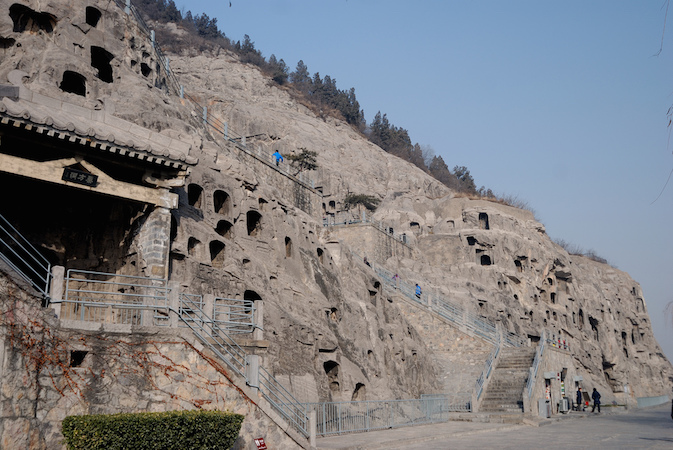Longmen caves
Longmen caves. Luoyang, China. Tang Dynasty. 493–1127 C.E. Limestone.
- the 2300 caves and niches filled with Buddhist art at Longmen in China
- The steep limestone cliffs extend for almost a mile and contain approximately 110,000 Buddhist stone statues, 60 stupas (hemispherical structures containing Buddhist relics) and 2,800 inscriptions carved on steles (vertical stone markers).
- Starting as early as the 1st century C.E., Buddhism brought to China new images, texts, ideas about life and death, and new opportunities to assert authority. The Longmen cave-temple complex, located on both sides of the Yi River (south of the ancient capital of Luoyang), is an excellent site for understanding how rulers wielded this foreign religion to affirm assimilation and superiority.
- Most of the carvings at the Longmen site date between the end of the 5th century and the middle of the 8th century—the periods of the Northern Wei (486–534 C.E.) through early Tang dynasties (618–907 C.E.).
- myriad of carvings painted in brilliant blue, red, ochre and gold
- The central Buddha; Ripples of folds cascade over the front of his throne. These linear and abstract motifs are typical of the mature Northern Wei style; flattened, elongated bodies
- The flattened, elongated bodies of the Longmen bodhisattvas (image left) are hidden under elaborately pleated and flaring skirts. The bodhisattvas wear draping scarves, jewelry and crowns with floral designs. Their gentle, smiling faces are rectangular and elongated.
- Two relief carvings of imperial processions once flanked the doorway of the cave entrance.
- These reliefs are the most tangible evidence that the Northern Wei craftsmen masterfully adopted the Chinese aesthetic. The style of the reliefs may be inspired by secular painting
- This imposing group of nine monumental images carved into the hard, gray limestone of Fengxian Temple at Longmen is a spectacular display of innovative style and iconography.
- Sponsored by the Emperor Gaozong and his wife, the future Empress Wu, the high relief sculptures are widely spaced in a semi-circle.
- Vairocana represents the primordial Buddha who generates and presides over all the Buddhas of the infinite universes that form Buddhist cosmology. This idea—of the power of one supreme deity over all the others—resonated in the vast Tang Empire which was dominated by the Emperor at its summit and supported by his subordinate officials. These monumental sculptures intentionally mirrored the political situation.



